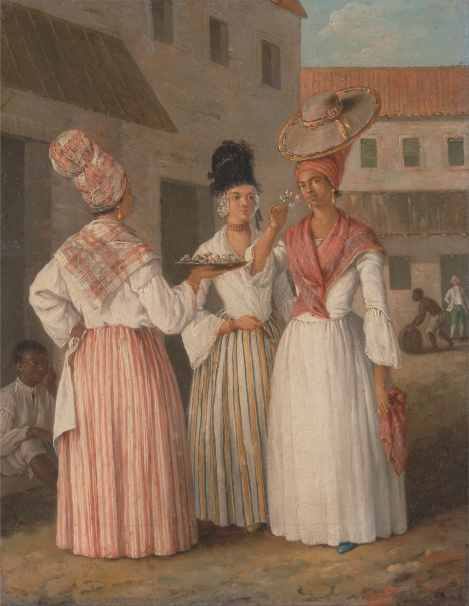A West Indian Flower Girl and two other Free Women of Color, as painted by Agostino Brunias
The years preceding the Abolition of Slavery in the British Empire on August 1, 1834, were turbulent years for the Catholic Church in the West Indies.
The Church had to adapt itself from being the church of the French planters and colonists to a church with a majority of members of African descent.
Some of these were free coloured and enfranchised blacks. While some of them were economically powerful, they did not have any say in the running of the colony Dominica.
The political rights and recognition of the free coloured people in the Dominica’s society was blocked by the whites-only Dominica Assembly. Their right to political representation was frustrated till September 1832, barely two years before the abolition of slavery.
One of the reasons of this stonewalling was the fact that ¾ of the free coloured population in Dominica was Roman Catholic.
In 1822 “the Coloured inhabitants of Dominica” presented a Petition and Memorial to Lord Bathurst, the British Colonial Secretary, claiming that they were “ an oppressed class of free people”. In response to their petition, the all-white Protestant Dominica Assembly found that they “ had not been able to discover out of the whole free coloured population [in Dominica] more than 12 persons who are at all qualified by education to have the smallest pretence to such a right [to political representation and office] and even of that number a part are Roman Catholics which persuasion is followed by about three quarters of the whole free coloured population of the island. ”
By 1825 the free black and coloured population in Dominica amounted to 3122 while the white population was estimated at just about 900.
What can we find in records and documents about the free coloured and free black population in Dominica ?
Patrick L. Baker wrote that “There were only 30 free coloured settlers in Dominica in 1730, comprising 7.9 per cent of the settler population, but this category was to grow and become a significant force in the island. By 1763, there were 300, comprising 14 % of the settler population. ” [CENTRING THE PERIPERY; CHAOS ORDER AND THE ETHNOHISRTORY OF DOMINICA- by Patrick L. Baker 1994] .
“ These free coloured inhabitants, known as ‘Afranchis’ as well as ‘mulatre’, owned large portions of the cultivated land ” wrote Dr. Lennox Honychurch in THE DOMINICA STORY.
In the Slave Registers of 1799, we find several slave owners mentioned as “free”. One of them was “Sally, a free woman” in the Parish of Saint Andrew who owned one male slave and three female slaves.
Thomas Rainy, a coloured gentleman in the Parish of Saint Peter , owned 76 male and 57 female slaves.
There were also free Africans : “Serafine, a free Negress” with 3 female slaves; “Rachel, a free Negress” and “Jean Boidore a free Negro” in the Parish of Saint Peter.
In the Parish Records of Grandbay, we found in the year 1748 the baptism of “Louis , a free coloured” son of Mr. Dubique, slave owner and his female slave Marguerite. There is also “Gertrude , a free negro woman” who had 2 slaves.
Some of the coloured population that emigrated to Dominica and claimed to be free coloured might have been escaped slaves from the French, Spanish or Dutch islands. Langford Love wrote in 1818 that “A free person of colour also is obliged… to pay a certain sum upon coming into the colony by way of security for good behaviour and to prevent the introduction of vagabonds and rogues ” [A LETTER TO A FRIEND, RELATIVE TO THE PRESENT STATE OF THE ISLAND DOMINICA.]
In 1822 the Dominica Assembly referred to “a tax of £1.13 to be paid by free persons of colour coming from other islands to reside here—this is to prevent slaves arriving here and passing as free persons” [Fr. Proesmans’ unpublished manuscript].
There was another source or origin of free coloured and blacks in Dominica : MANUMISSION.
Studying the Slave Registers of 1823, I recorded about 73 manumissions of slaves in the period 1820-1823.
These we can divide in several groups :
Group one : old slaves, 50 years and over.
I take as example “Charlemagne” who was 66 years old when his owner WW Glanville gave him his freedom. Or “John” a carpenter aged 53 years , slave of John Louis Bostick.
One can ask the question if they were freed out of mercy or appreciation for their years of faithful service or if this was a way to get rid of “useless” slaves, who were a burden to their owner? Who took care of these old slaves who might have been sick and infirm?
The second group of enfranchised slaves were “SOLD TO SELF ”
It seems that some slaves had accumulated enough money to buy themselves free. We know that the Dominica Assembly levied a tax of “only” £ 6.10 on each officially recognised liberation of a slave. The British government compensated slave owners between £ 29 and 30 Pound Sterling per slave. So quite a lot of money was involved if a slave wanted to buy his freedom. We find “ Joachim” , a Creole slave at Morne Patate Estate who was “sold to self ” on Dec 30, 1820. He was 53 years old. Also “Philipe” , an African male slave of Jean Louis Bellot, 50 years of age, was “sold to himself” and several others.
Next week, we will continue to study the manumitted or enfranchised slaves and the lot of the free population of Dominica in the decade before the Emancipation of Slaves in 1834.

